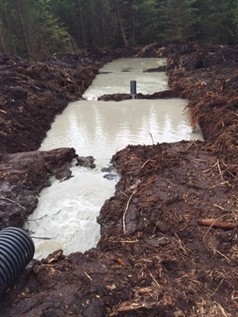Prepare to deliver: Pollution Prevention Planning
- Simon Knott
- Apr 3, 2024
- 2 min read
The repercussions associated with pollution events can range from minor delays to significant financial penalties and, in the worst cases, irreversible environmental damage. The root of the problem often lies in a lack of preparedness and understanding of how to effectively manage and prevent pollution during the construction phase.
Whether your project requires a Pollution Prevention Plan (PPP) because it’s part of the environmental planning process, a contractual obligation, or you just want to do the right thing, developing a PPP helps to reduce risk of pollution and protect your project.
The Pollution Prevention Plan
A PPP is your first line of defence against the environmental incidents that can derail your construction project. Tailored to the specific needs of your construction site, a well-crafted PPP addresses the unique challenges posed by your project's methods, schedule, and location. It's not just a regulatory requirement but a blueprint for sustainable project management.
Why it matters
In the construction phase, the risk of waterborne pollution impacting the surrounding environment is at its highest. Without a robust PPP, you're navigating blind in a field rife with potential pitfalls. From sediment run-off to chemical spills, the threats are varied but the solution is clear: proactive pollution prevention.
Common pitfalls to avoid
Misusing solutions: Sustainable Drainage Systems (SuDS) are excellent for long-term environmental management – when the aim is to discharge water at a slow enough rate so that it doesn’t present a flood risk – but fall short during construction. They're simply not designed to handle the type and high levels of pollutants present during this phase.
Read more...
SuDS are typically designed to handle water flow over finished surfaces, using a "pollution factor" for operational phase pollutants. In contrast, construction phase pollutants, notably suspended solids, require treatment systems tailored to flow rates and particle sizes, favouring shallow systems for effective settlement. Essentially, SuDS and construction phase treatment systems are engineered for distinctly separate purposes, highlighting the need for phase-specific water management approaches.
2. Inadequate treatment systems: All too often, settlement ponds and other treatment systems are undersized or improperly designed, leading to ineffective pollution control.
Read more...
Despite guidelines, the implementation of adequately sized treatment systems to prevent silt pollution during construction projects is rare. Settlement ponds, crucial for capturing silt and meeting environmental obligations, are often too small, due to either space limitations or oversight in design as highlighted in CIRIA guidance.
While models predict precipitation and surface flow, factors like excavation dewatering and pump outputs, which are constant, aren't always adequately accounted for. For example, turning off a pump can stop a pollution event, but managing the discharge from a six-inch pump full of clay particles demands substantial space for effective water treatment. The size of treatment ponds should be based on established surface water flow models or the maximum output of the pump in use, ensuring they are equipped to handle the volume and type of runoff encountered.
3. Overreliance on basic filtration: Silt fences and straw bales might seem like convenient solutions, but they're not up to the task of protecting your site from pollution.
Read more...
The practic
e of relying heavily on filtration methods like silt fencing, straw bales, and vegetation for managing silt during construction phases often falls short of effectively preventing pollution. Silt fences can only block solids larger than their mesh size, leading to potential overflow and ineffective filtration as they clog and halt water flow, inadvertently becoming check dams that can be easily overwhelmed.
Similarly, using vegetation for filtration is unreliable, especially during high rainfall, as saturated soil allows water to flow over rather than through it, raising the risk of pollution events. Straw bales, while acting as check dams, fail to filter out pollutants and can cause flooding if improperly sized.
Moreover, inserting these filtration systems directly into streams or watercourses to address sediment issues is risky and constitutes a pollution offence, as it introduces sediment into natural water bodies and poses flood risks. Effective silt management requires more comprehensive and reliable solutions beyond these conventional, but often inadequate, filtration methods.
4. Neglecting water management: Effective pollution prevention requires a proactive approach to managing water flow on and around your construction site.
Read more...
A proactive approach to water management on construction sites is crucial for preventing pollution. Without isolating the site from upstream surface water flow, sites may face an unmanageable increase in water volume, potentially overwhelming treatment systems not designed for such capacity. Failing to divert clean, upstream water away from or around the construction area not only increases the risk of contaminating this water but also escalates project costs due to the need for treating a greater volume of water. Effective water management entails preparing for and mitigating these increased volumes to avoid environmental and financial repercussions.
Our top tips for effective pollution prevention
Customise your plan: Ensure your PPP is designed specifically for the construction phase, taking into account your project's unique challenges.
Size matters: Use modelling techniques to ensure your treatment systems are adequately sized.
Diversify your approach: Combine different silt control measures for comprehensive protection.
Manage water proactively: Keep clean and dirty water separate to minimise pollution risks.
Don't let pollution delays and fines become your project's legacy
Take control of your project's environmental impact. By investing in a comprehensive Pollution Prevention Plan, you're not just complying with regulations; you're safeguarding your project's timeline, budget, and reputation.
Contact us today to learn how our expert guidance can steer your project to success, free from the setbacks of pollution-related delays and increased costs.
Additional information
There are several guidance documents in publication that outline specific good practice approaches. Here are a few:
SEPA’s free WAT-SG 75 Water Run Off From Construction Sites
CIRIA Guidance Document Control of water pollution from linear construction projects. Site guide (C649)
CIRIA Guidance Document Control of water pollution from construction sites. Technical guidance (C648).








